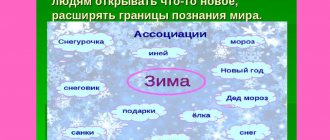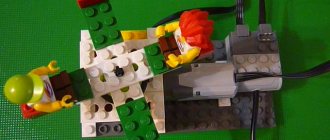Olga Ivanova
Card index of fun games for older children
Card index of games - fun for older children
Prepared by: teacher Ivanova O.V.
Fun games No. 1
«Potato»
Goal: To encourage emotional responsiveness, develop communication skills with adults and peers.
Move: All players stand in a circle and pass the ball to each other, hitting it. If someone does not hit the ball, he squats in the center of the circle and the game continues. Any player can help out the “offender” if he wishes. To do this, when hitting the ball, he tries to hit those sitting in (the one who was touched by the ball)
takes part in the game again.
Those sitting inside the circle try to catch the ball flying towards them.
If someone succeeds, then all those “punished” return to the game, and the player who threw the ball takes their place. Fun games No. 2
"Paints"
Goal: To encourage emotional responsiveness, develop communication skills with adults and peers.
Move: One of the players is the “buyer”, the other is the “seller”, all the rest are the “paints”. Each “paint” wished for its own color and told it to the “seller”. “Paints and the seller” sit on the bench and the buyer immediately comes: “Knock-knock!” “Who’s there?” asks the seller. "I, the buyer." “Why did you come?” “For paint”, “For which one?” A specific paint color is called; if it is not there, the “seller” replies: “There is no such thing. Jump along the path on one leg!” The “buyer” makes a circle on one leg and returns for more paint. If there is paint, the “seller” says: “There is one. Pay... rubles." The “buyer” “pays” - by clapping his palm the required number of times, the “paint” jumps up and runs away. The “buyer” tries to catch the paint ; if it succeeds, the “paint” becomes the “buyer”.
Fun games No. 3
"The quieter you go, the further you'll get "
Goal: To encourage emotional responsiveness, develop communication skills with adults and peers.
Progress: At a distance of 30 meters from each other, two lines are drawn - “ start ” and “finish”. The players stand at , the driver stands with his back to them at the finish line. He says the phrase: “The slower you go, the further you will go. One two Three!". During this time, players try to get as close to the finish line as possible. Having finished speaking, the “driver” quickly turns around and examines the participants in the game, who must freeze. The one who moves goes beyond the starting . the start line first wins . He becomes the driver.
Fun games No. 4
"Dodgeball"
Goal: To encourage emotional responsiveness, develop communication skills with adults and peers.
Move: All players, except two, stood in a line in the center of the court. They, throwing the ball to each other, had to knock out all the players. The one who was touched by the flying ball comes out! from the game. When all players were eliminated, the game started over.
Fun games No. 5
"Ring"
Goal: To encourage emotional responsiveness, develop communication skills with adults and peers.
Procedure: Play while sitting on a bench. Everyone folds their palms in a boat, and the leader, who has a small object in his palms (a ring, a pebble), runs his hands between the palms of each player, quietly puts a ring in someone. Stepping aside, he says: “Ring, ring, go out onto the porch! "The player with the "ring" must quickly stand up, and the other participants must hold him. If it was successful, he became the leader.
Fun games No. 6
"Magic Palms"
Task: exercise to develop a sense of one’s own movement.
Progress of the game:
“Water, water,
Wash my face (children perform washing movements)
To make the eyes sparkle (children show round eyes)
To make the cheeks red (children hold their cheeks)
So that the mouth laughs (children smile)
And the tooth bit him.” (children click their teeth)
Fun games No. 9
“Our Masha is small.”
Purpose: exercise to develop a sense of self-movement
Table: tasks and techniques for mastering round dance games
| Age group | Problems of round dance games | Organization of games | Mastering techniques |
| First youngest (1.5–3 years) |
| Kids learn to stand in a circle and dance in a circle. At the beginning of learning round dance games, it is recommended to place a toy in the center of the circle; it will serve as a guide for the children. At first, it is difficult for children of the second year of life to move clearly in a circle. To help them, you can mark a circle on the floor with electrical tape or stickers. The song is performed by adults: teacher, music director, physical education instructor, parents. They learn the round dance game several times a week. | Demonstration of the game by adults (demonstrated by the teacher and nanny, music director and teacher, etc.). |
| Second youngest (3–4 years) |
| Movements in a circle become more difficult:
The songs are performed by adults, encouraging children to sing along. The round dance game is learned daily: at leisure, during a music lesson, while walking. |
|
| Medium (4–5 years) |
| Children perform round dance songs on their own. In the first half of the day, the teacher learns the text with the children, in the second half - the movements. | |
| Senior (5–6 years old) |
| Older preschoolers quickly learn the words of songs. And the movements of round dance games become more complex: formation according to the rules and formation of figures appear. It is recommended to learn round dance movements in the first half of the day, and the lyrics of the song in the second. The new game should be repeated with the children 2-3 times during the day, for reinforcement - 1-2 times. |
|
| Preparatory (6–7 years) |
|
Round dance games belong to the folklore genre. Dance movements, plots and melodies of songs were invented by the people and have been preserved since ancient times. There are modern musical arrangements for round dance games; it is recommended to use them infrequently: at festive events or sports activities. The main meaning in learning round dances is contact with the world of Russian folk art. Let children feel the beauty of melodies and movements in their simplicity.
Children's round dance games are not only circular. The formation of the figures is borrowed from folk dance:
- “Wall to wall”, “Vorottsa”: participants line up in two lines and stand opposite each other.
For one musical phrase, the wall “finds” the wall and returns to its place, then the second line finds it. Moving towards is possible for both lines. To make a gate, the first participants in the lines join hands, and the round dance chains pass under them. In the round dance game “Like Ours at the Gate,” the chain of participants passes through the gate formed by the leaders - There is only one “circle”.
Russian folk round dances are characterized by movement in the direction of the sun, that is, clockwise. But in play dances the opposite direction is also possible. For example, in the Carousel game, participants spin the ribbons first in one direction, then turn around and spin the carousel. In games, it is possible to build two separate circles or a circle within a circle. Most often, round dances with preschoolers take place in a circle - “Snail”, “Cabbage”: twisting the round dance chain into a spiral.
This figure is created when one of the participants breaks the circle and begins to move in such a way that the chain wraps around an improvised center. This game also involves returning to the circle: the leader runs from the center of the cabbage (snail) and begins to move in a large circle. In the round dance game “Cabbage,” the leader twists the chain in the form of a spiral - “Snake”: the leader directs a round dance to form a zigzag pattern.
The round dance chain, when formed with a snake, draws a zigzag pattern
Experienced teachers usually introduce children to the circular formation of a round dance and games like “Snake”, rarely with “Cabbage” and “Vorottsy”. At events in the kindergarten that my children attend, I observed round dance games at Maslenitsa festivities and the autumn festival. Traditionally, round dances are held at New Year's matinees. The game form includes a round dance in which the content of the song determines the movements. In the younger group, the son and classmates were bunnies, for example, and in a round dance they jumped, wagged their tails, shook their ears. At sports festivals it was fun to play the snake round dance. Parents and children joined hands, and the leader (usually the most active dad is chosen) led this long chain at high speed with dashing patterns.
Progress of the game:
Our Masha is small, (children bend down to the floor and show little Masha)
She is wearing a scarlet fur coat (children show the fur coat)
Beaver edge (children spread their hands and show the edge)
Masha black-browed (children point to eyebrows)
Fun games No. 10
“Cucumber, cucumber.”
Purpose: exercise to develop a sense of self-movement
Progress of the game: At one end of the playground there is a teacher (trap, at the other there are children. They approach the trap by jumping on two legs. The teacher says:
Cucumber, cucumber,
Don't go to that end
There's a mouse living there
He'll bite your tail off.
At the last words, the children run away, and the teacher catches up with them.
Fun games No. 11
Purpose: exercise to develop a sense of self-movement
Games and fun in kindergarten for children 3-5 years old
Games and fun for children of primary preschool age, preschool educational institution
Author: Dvoretskaya Tatyana Nikolaevna GBOU School No. 1499 Preschool No. 7 Educator Description: Games are intended for children of primary preschool age, can be useful material for teachers of preschool organizations and parents. Purpose of the work: Author's games for children are aimed at developing the socialization of children, arousing interest and desire to play joint games
Goal: to develop in preschool children the interest and need to play with peers Objectives: 1. to arouse interest in group games in preschool children 2. to form in children a positive attitude and desire to play joint games 3. to cultivate a friendly attitude when playing with peers 4. to develop the cognitive and speech activity of children through play. Preface In modern pedagogical theory, play is considered as the leading activity of a preschool child.
The leading position of the game is determined not by the amount of time that the child devotes to it, but by the fact that it satisfies his basic needs. In the depths of the game, other types of activities arise and develop. Play contributes to mental development to the greatest extent. Dear teachers, I present to your attention my original games for children. I hope the material will be useful and in demand in your work. Game No. 1: “Top-top-top” for children 3-5 years old
This game can be played with children of primary preschool age, both in a group and on the street.
Rules of the game: - Children stand next to the teacher and form a small circle. — The words for the game are pronounced in chorus, rhythmically, with the addition of movements according to the meaning of the text (when learning the game, the teacher will need to show you)
Words for the game: One - Two! Three four! (children take 4 steps back)
We will make a wider circle
(form a large circle without holding hands)
We will smile at a friend nearby
(turn and smile)
We will hold hands tightly.
(Hold hands)
Step by step we will go, stretch our legs.
Top - top - top! The guys are coming Top - Top - Top! They are going somewhere. (rhythmic steps are taken to the right)
Stop at the gate.
(stopped and stood still)
So there will be a turn.
(turn to the left)
The children turned around together!
You need to keep moving. Step by step we will go, stretch our legs. Top - top - top! The guys are coming Top - Top - Top! They are going somewhere. (rhythmic steps are taken to the left)
Past the river and lakes.
Past the forest, past the mountains. Everyone is walking, their feet are moving. Stop - stop - stop. End of the road. (stopped and stood still)
We have arrived!
Meet us. (turn your face in a circle, stretch 2 arms forward)
And clap 5 times.
(Clap your hands)
Game No. 2: “Snake” for children 3-5 years old
The game is played outside while walking.
Attributes for the game: - A snake drawn with yellow chalk (paint) on the asphalt and 5-6 multi-colored circles (balls) Rules of the game: - Children line up one after another - They say in chorus the call for the game Call for the game: The snake played with balls This is how it played that I'm tired. The poor thing lay down in the shade and was too lazy to crawl any further.
Words for the game (pronounced by the teacher) One, two, three, four, five I invite you to play. We will go with you along the path along the curve. (running along the snake one after another)
Don’t be timid, my friend.
You run forward quickly. Hide your hands behind your back. Jump on the ball with your feet. (jumping on 2 legs)
One!
Two! Three! Four! Five! We know how to win. Hurray for the champions! The game continues. (Children who have run all the way return to the end of the snake’s tail and, if desired, go through it again)
The game can continue until the children’s interest remains.
Recommendations: The second player starts moving only after the first player reaches the middle of the snake.
Game No. 3: “Cats and Mouse” for children 3-5 years old
This game can be played with children of primary preschool age, both in a group and on the street.
Attribute for the game: - Cat mask Characters: Cat - child Mice - children
Rules of the game: - Child - a cat sits on a chair (in the bushes) - Children - mice are running away from the cat Words for the game: The mice decided to go for a walk. Fidgety - naughty girls. (Children-mice go out for a walk on tiptoe)
Here they are running along the grass Zipper – Zipper – Zipper
(running into the loose grass)
They jumped over the ditch
(jumping on 2 legs)
Jump – Jump – Jump Suddenly a terrible sound was heard
(The teacher knocks on the chair with a stick, on which the cat sits)
And the heart KNOCK - KNOCK - KNOCK The cat hid in the bushes And opened its toothy mouth.
The mice will be in trouble for you. Run away in all directions... (The cat begins to catch the mice, trying to hit them on the shoulder. The mice run away)
Parting words from the author:
There are a lot of games, entertainment and activities in our world. You should never be bored in the company of friends!
We recommend watching:
Water games for the second younger group. Card index Fun game “Roosters” for the younger group Nursery rhyme “Chicks” for games with children of the younger group Musical games for the younger group of kindergarten
Similar articles:
Coloring pages for children “Pets”
What are educational games for preschoolers
Games to develop attention for children 3-4 years old in kindergarten in a group
Didactic games in the younger group. Card index
Playing with sand in the younger group





